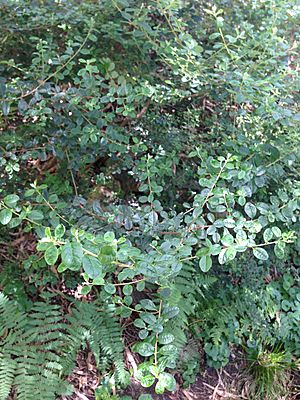Round-leaf pomaderris facts for kids
Quick facts for kids Round-leaf pomaderris |
|
|---|---|
 |
|
| Scientific classification |
The round-leaf pomaderris (scientific name: Pomaderris vacciniifolia) is a type of spreading shrub. It is only found in Victoria, Australia. This means it is "endemic" to that area.
Contents
What is the Round-Leaf Pomaderris?
The round-leaf pomaderris is a shrub that spreads out. It has leaves that are shaped like circles, which is how it got its name. This plant is a special part of the Australian environment.
Why is This Plant Special?
This plant is very important because it is quite rare. In 2005, experts listed it as "vulnerable." This means it could become endangered if we don't protect it.
In 2008, people became more aware of how special this plant is. Some plants were accidentally damaged during a construction project. After this, the government's science group suggested protecting the plant. It was officially added to the Protected Flora List in 2010. This list helps keep rare plants safe.
Where Does the Round-Leaf Pomaderris Live?
Most of the remaining wild round-leaf pomaderris plants live in a place called Toolangi. This area is about 70 kilometers (about 43 miles) northeast of Melbourne. It is the main place where you can still find many of these plants growing naturally.
What Threats Does it Face?
Sadly, the number of round-leaf pomaderris plants has been going down. Several things threaten this special shrub:
- Deer eating plants: Wild deer, called "feral deer," eat the plants.
- Land clearing: Areas where the plant grows are sometimes cleared for other uses.
- Bushfires: Big fires, like the 2009 Black Saturday bushfires, can destroy many plants.
Who Discovered This Plant?
The round-leaf pomaderris was first described in 1858. An Austrian botanist named Siegfried Reisseck was the scientist who officially named and recorded the plant.

